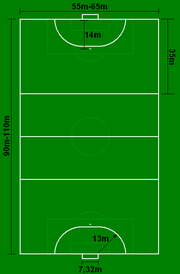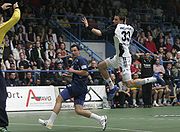Handball (also known as team handball, field handball, European handball, or Olympic handball) is a team sport where two teams of seven players each (six players and a goalkeeper) pass and bounce a ball trying to throw it in the goal of the opposing team.
The game has a goal similar to but smaller than the one in association football, though as the name implies, the basic method of handling the ball involves the players' hands rather than their feet. The game has been played internationally since the 1920s.
History[]

Dimensions of a field of field handball played with 11 players at 1936 Summer Olympics compared to a football field.
Team handball has origins reaching as far as antiquity: urania in ancient Greece, harpaston in ancient Rome, fangballspiel in medieval Germany, etc. There are also records of handball-like games in medieval France, and among the Inuit in Greenland, in the Middle Ages, and in Ancient Africa, primarily Egypt. By the 19th century, there existed similar games of haandbold from Denmark, hazena in Bohemia and Slovakia, gandbol in Ukraine, torball in Germany, as well as versions in Ireland and Uruguay.
The team handball game as we know it today was formed by the end of the 19th century in northern Europe, primarily Denmark, Germany, Norway and Sweden. The Dane Holger Nielsen drew up the rules for modern handball (håndbold) in 1898 (and published them in 1906), and R.N. Ernst did something similar in 1897.
Another set of team handball rules was published on 29 October 1917 by Max Heiser, Karl Schelenz and Erich Konigh from Germany. After 1919 these rules were further improved by Karl Schelenz. The first international games were played under these rules, between Germany and Belgium for men in 1925 and between Germany and Austria for women in 1930.
In 1926, the Congress of the International Amateur Athletics Federation nominated a committee to draw up international rules for field handball. The International Amateur Handball Federation was formed in 1928. The International Handball Federation was formed later in 1946
Men's field handball was played at the 1936 Summer Olympics in Berlin at the special request of Adolf HitlerTemplate:Fact. It was removed from the list of sports, to return as team handball in 1972 for the 1972 Summer Olympics in Munich. Women's team handball was added as an Olympic discipline at the 1976 Summer Olympics.
The International Handball Federation organized the Men's World Championships in 1938 and every 4 (or sometimes 3 years) from World War II to 1995. Since the 1995 World Championship in Iceland, the competition has been held every two years. The Women's World Championships have been played since 1957. The IHF also organizes Women's and Men's Junior World Championships.
As of February 2007, the IHF lists 159 member federations which represent approximately 1,130,000 teams and a total of 31 million players, trainers, officials and referees.[1]

A 7 m penalty shot.
Playing field[]
Handball is played on a court 40 meters long by 20 meters wide (40m x 20m), with a dividing line in the middle and a goal in the center of either end. The goals are surrounded by a near-semicircular line that is generally six meters (6m) away from the goal, called the crease. There is also a dashed near-semicircular line that is nine meters (9m) away from the goal. In established play (which is most of the time, although counterattacking is becoming increasingly important), the defenders stand right outside the 6 m line, with the attacking players throwing the ball to each other a bit outside the 9 m line, trying to create an attack (either by shooting from a distance, or passing to a player standing at the 6 m line).
After a goal has been scored, the team conceding the goal restarts the game. Its players move to the center line. Once a player has the ball under control the referee will blow his whistle to restart play. All players of the team which are restarting the play must be behind the line on their own half, or else the restarting throw will have to be retaken.
Only the defending goalkeeper is allowed to step inside the six meter (6m) perimeter, though any player may attempt to catch and touch the ball in the air within it. If a player should find himself in contact inside the goal perimeter he must immediately take the most direct path out of it. Should a defender make contact with an attacker while in the goal perimeter, their team is penalized with a direct attempt at the goal, with only one attacker on the seven-meter line and the defending goalkeeper involved.
The ball is smaller than a football in order for the players to be able to hold and handle it with a single hand (though contact with both hands is perfectly allowed). Some American versions use a volleyball. It is transported by bouncing it between hands and floor — much as in basketball. A player may only hold the ball for three seconds and may only take three steps with the ball in hand. After taking three steps the player will have to make a dribble with one hand in order to continue moving forward, but if the ball is held in both hands after making a dribble and the player makes another dribble, a free throw will be given to the other team for a "double dribble". There are many unofficial rule variations; a common American version allows only a single step with the ball, after which the player must pass the ball to another teammate or shoot.

Women's Handball - a jump shot.
Ball movement and possession is similar to basketball. If the attacker commits an infraction, such as charging, the possession of the ball can be awarded to the defending team. Players may also cause the possession to be lost if they make more than three steps without dribbling or after stopping their dribble. However unlike basketball, the player may take three steps instead of two (pivoting on one foot is considered a step) and the ball must be "patted" down instead of the more control.

Size and line pattern of a handball field.

Typical scene in a handball game.
Game play[]
A standard match duration consists of two periods of 30 minutes each during which each team may call one time-out. Normal league games are usually allowed to end in a draw, but in knockout tournaments, such as the Olympics, two extension periods of 5 minutes are played, and if they also end in a draw another two times 5 minutes has to be played. If each of these ends in a tie after the extra time the winner is determined by an individual shootout from the 7-meter line, where each team is given five shots. The rules of the shootout are similar to soccer shootouts, where, if a winner is not found within the first ten shots, the players return to the shooting, until one team has missed and the other scored. In two Olympic Finals of women's handball penalty shootout had to be used - both of them with Denmark participating (against Hungary in 1996 and South Korea in 2004); and both of them with Denmark as the winner.
The game is quite fast and includes body contact as the defenders try to stop the attackers from approaching the goal. Only frontal contact by the defenders is allowed; when a defender stops an attacker with his or her arms instead of his or her torso, the play is stopped and restarted from the spot of the infraction or on the nine meter line, with the attacking team in possession.
The usual formations of the defense are the so-called 6-0, when all the defense players are within the 6 meter and 9 meter lines; the 5-1, when one of the players cruises outside the 9 meter perimeter, usually targeting the center forwards; and the least common 4-2 when there are two such defenders. The usual attacking formation includes two wingmen, a center-left and a center-right which usually excel at high jumps and shooting over the defenders, and two centers, one of which tends to intermingle with the defense (also known as the pivot or try line player, somewhat similar to the hole set (2 m) in water polo), disrupting the defense formation, and the other being the playmaker (similar to basketball). Also the players may use the "box plus one" defense in which the players line up in a box form and the extra player will attack the other team's player who has the ball while the others guard the goal area and try to intercept passes. The formations vary greatly from country to country. The most common formation for the central European teams as well as the Scandinavian teams is 6-0. This formation can be altered to 5-1 by placing a player--usually the far wing--in the middle in front of the 9-meter perimeter to disturb the play of the other team. The Ukrainian team "HC Motor Zaporyshe" plays a 3-3 formations with man marking all over their defensive area. This formation is used by teams outside Eastern Europe only when behind with a few goals with a few minutes left, in the attempt to steal the ball faster.
Goals are much more common in handball than in most other sports; usually, both teams score at least 20 goals each, and it is not uncommon to have a match end (say) 33-31. This was not true in the earliest days, when the scores were more akin to that of ice hockey, but as offensive play (in particular in terms of counterattacks after a failed attack from the other team) has improved, more and more goals have been scored after each match.
Penalties[]
Penalties are given to players, in progressive format, if the contact between the players is particularly rough (even if it is indeed frontal) the referees may award a nine-meter free throw to the attacking team, or if the infraction was during a clear scoring opportunity, a seven-meter penalty shot is given. In more extreme cases they give the defender a yellow card (warning), a 2-minute penalty, or a red card (disqualification). For rough fouls they can also order two-minute expulsions or a red card without having to warn the player. A player who is disqualified may be substituted with another player after two minutes. If a player assaults a referee, an opponent or any other person severely and deliberately, the referee can expel the player forming a cross over his head with his arms, which will tell the player that he/she will have to leave the game completely and can't be substituted for the rest of the game. An expulsion results in a quarantine for the player shown out. Disqualifications may also lead to a quarantine for the respective player. A team can only get three warnings (yellow cards); after that they will only be able to be penalized with 2-minute suspensions. One player can only get three 2-minute suspensions; after that he/she will be shown the red card, and cannot participate in that game anymore. A red card from three 2-minute suspensions does not result in a quarantine. A Coach/Official can also be penalized progressively. After a yellow card and a 2-minute suspension, the red card is shown straight out, and unlike players, coaches cannot be shown a complete expulsion, but of course also be given a match quarantine. When shown a 2-minute suspension a coach will have to pull out one of his players for two minutes - note: the player is not the one punished and can be substituted in again, because the main penalty is the team playing with a man less than the other.
After having lost the ball during an attack, the ball has to be laid down quickly or else the player not following this rule will face a 2-minute suspension. Also gesticulating or verbally rejecting to follow the referee's order, as well as arguing with the officials decisions, will normally result in a 2-minute suspension. Alternatively, if it is done in a very provocative way, a player can be given a 2-minute suspension if he/she does not walk straight off the field to the bench after being given a suspension, or if the referee deems the tempo deliberately slow.
